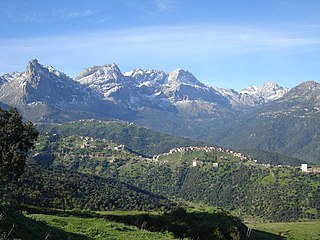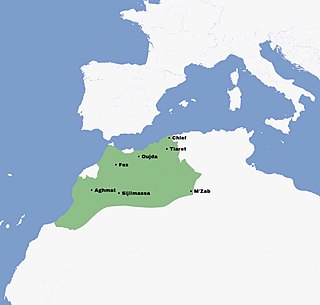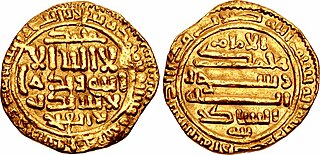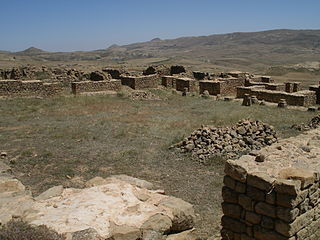
Much of the history of Algeria has taken place on the fertile coastal plain of North Africa, which is often called the Maghreb. North Africa served as a transit region for people moving towards Europe or the Middle East, thus, the region's inhabitants have been influenced by populations from other areas, including the Carthaginians, Romans, and Vandals. The region was conquered by the Muslims in the early 8th century AD, but broke off from the Umayyad Caliphate after the Berber Revolt of 740. During the Ottoman period, Algeria became an important state in the Mediterranean sea which led to many naval conflicts. The last significant events in the country's recent history have been the Algerian War and Algerian Civil War.

The Fatimid Caliphate was a caliphate extant from the tenth to the twelfth centuries AD under the rule of the Fatimids, an Isma'ili Shi'a dynasty. Spanning a large area of North Africa and West Asia, it ranged from the western Mediterranean in the west to the Red Sea in the east. The Fatimids trace their ancestry to the Islamic prophet Muhammad's daughter Fatima and her husband, ‘Ali ibn Abi Talib, the first Shi‘a imam. The Fatimids were acknowledged as the rightful imams by different Isma‘ili communities as well as by denominations in many other Muslim lands and adjacent regions. Originating during the Abbasid Caliphate, the Fatimids conquered Ifriqiya and established the city of al-Mahdiyya. The Fatimid dynasty ruled territories across the Mediterranean coast and ultimately made Egypt the center of the caliphate. At its height, the caliphate included—in addition to Egypt—varying areas of the Maghreb, Sicily, the Levant, and the Hejaz.

Kabylia is a mountainous coastal region in northern Algeria and the homeland of the Kabyle people. It is part of the Tell Atlas mountain range and is located at the edge of the Mediterranean Sea.

The Hammadid dynasty was a branch of the Sanhaja Berber dynasty that ruled an area roughly corresponding to north-eastern modern Algeria between 1008 and 1152. The state reached its peak under Nasir ibn Alnas during which it was briefly the most important state in Northwest Africa. Its realm was conquered by the Almohad Caliphate.

The Zirid dynasty, Banu Ziri, was a Sanhaja Berber dynasty from what is now Algeria which ruled the central Maghreb from 972 to 1014 and Ifriqiya from 972 to 1148.
The Zenata are a group of Berber tribes, historically one of the largest Berber confederations along with the Sanhaja and Masmuda. Their lifestyle was either nomadic or semi-nomadic.
Al-Qaid Jawhar ibn Abdallah was a Shia Muslim Fatimid general who led the conquest of Maghreb, and subsequently the conquest of Egypt, for the 4th Fatimid Imam-Caliph al-Mu'izz li-Din Allah. He served as viceroy of Egypt until al-Mu'izz's arrival in 973, consolidating Fatimid control over the country and laying the foundations for the city of Cairo. After that, he retired from public life until his death.
Hammad ibn Buluggin was the first ruler of the Hammadid dynasty in what is now Algeria (1014–1028).

Buluggin ibn Ziri, often transliterated Bologhine, in full ʾAbū al Futūḥ Sayf ad Dawlah Bulukīn ibn Zīrī ibn Manād aṣ Ṣanhājī was the first leader of the Sanhaja Berber dynasty of Zirids to serve as viceroy of Ifriqiya under the Fatimid Caliphs, founding a dynasty that continued to rule the region after him.

al-Mansûr ibn Buluggin was the second ruler of the Zirids in Ifriqiya.
Bādīs ibn al-Manṣūr, known fully as ʾAbū Manād Bādīs Nāṣir al-Dawla, was the third ruler of the Zirids in Ifriqiya from 996–1016.

The Maghrawa or Meghrawa were a large Zenata Berber tribal confederation whose cradle and seat of power was the territory located on the Chlef in the north-western part of today's Algeria, bounded by the Ouarsenis to the south, the Mediterranean Sea to the north and Tlemcen to the west. They ruled these areas on behalf of the Umayyad Caliphate of Cordoba at the end of the 10th century and during the first half of the 11th century.

The Idrisid dynasty or Idrisids were an Arab Muslim dynasty from 788 to 974, ruling most of present-day Morocco and parts of present-day western Algeria. Named after the founder, Idris I, the Idrisids were an Alid dynasty descended from Muhammad through his grandson Hasan. Their reign played an important role in the early Islamization of Morocco and also presided over an increase in Arab immigration and Arabization in major urban centers.

The Kingdom of Tlemcen or Zayyanid Kingdom of Tlemcen was a kingdom ruled by the Berber Zayyanid dynasty in what is now the northwest of Algeria. Its territory stretched from Tlemcen to the Chelif bend and Algiers, and at its zenith reached Sijilmasa and the Moulouya River in the west, Tuat to the south and the Soummam in the east.
Zawi ibn Ziri as-Sanhaji or Al-Mansur Zawi ibn Ziri ibn Manad as-Sanhaji, was a chief in the Berber Sanhaja tribe. He arrived in Spain in 1000 (391) during the reign of Almanzor. He took part in the rebellion against the Caliphate of Córdoba and settled in the Cora of Elvira with followers from his Sanhaja tribe. He founded the Taifa of Granada, and founded the Zirid dynasty of Granada as its first Emir, reigning from 1013 to 1019.
Jawdhar, surnamed al-Ustadh, was a eunuch slave who served the Fatimid caliphs al-Qa'im, al-Mansur, and al-Mu'izz as chamberlain and de facto chief minister until his death. He was an extremely powerful figure in the Fatimid court, and was ranked immediately after the caliph and his designated heir. The accession of al-Mansur was probably due to Jawdhar's machinations, and he was placed in charge of keeping the new caliph's relatives under house arrest. He enjoyed close relations with the Kalbid emirs of Sicily, which enabled him to engage in profitable commerce with the island. Jawdhar accompanied al-Mu'izz during the migration of the court from Ifriqiya to Egypt, but died on the way at Barqa. His collected documents and letters were published after his death by his secretary as the Sirat al-Ustadh Jawdhar, and form one of the main historical sources for the governance of the Fatimid state in the period.

Muhammad ibn al-Fath Wasul ibn Maymun al-Amir was the tenth Midrarid emir of Sijilmasa. He was the first Midrarid ruler to adopt Maliki Sunni Islam.

Achir or Ashir is a medieval city in Algeria, first capital of the Muslim dynasty of the Zirids, which ruled under Fatimid suzerainty in the 10th–11th centuries. It is located at an altitude of 4,593 feet in the Titteri Mountains, in the current Algerian commune of Kef Lakhdar.
The Zirids conquered the western Maghreb in 979 when Buluggin Ibn Ziri led a campaign to expand his territory. He captured most of present-day Morocco by 980, which remained briefly under Zirid control until his death in 984.
The Fatimid campaigns in the western Maghreb were led by the Fatimid general Jawhar and Ziri ibn Manad between 958 and 960. They were directed against the rulers who had recognised the suzerainty of the Caliph of Cordoba.











